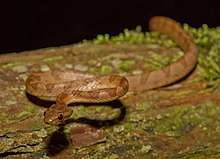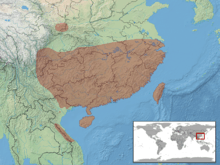Boiga kraepelini
Boiga kraepelini, commonly known as the square-headed cat snake, Kelung cat snake,[1] or Taiwanese tree snake[3] is a species of mildly venomous snake in the family Colubridae. The species is endemic to East Asia and Southeast Asia (Taiwan, China, Vietnam, and Laos).[1][2][4] Its specific name, kraepelini, honours Karl Kraepelin, a German naturalist.[4][5] The common name, Kelung cat snake, refers to its type locality, Keelung in northern Taiwan.[2]
| Boiga kraepelini | |
|---|---|
 | |
| Scientific classification | |
| Kingdom: | Animalia |
| Phylum: | Chordata |
| Class: | Reptilia |
| Order: | Squamata |
| Suborder: | Serpentes |
| Family: | Colubridae |
| Genus: | Boiga |
| Species: | B. kraepelini |
| Binomial name | |
| Boiga kraepelini Stejneger, 1902 | |
 | |
| Synonyms[2] | |
| |
Description
B. kraepelini is a long and thin snake that can grow to a total length (including tail) of 160 cm (63 in). Its head and eyes are large (the head is twice the width of the neck), hence the Chinese name meaning "big-headed snake" (simplified Chinese: 大头蛇; traditional Chinese: 大頭蛇; pinyin: dàtóushé). The pupils are cat-like, as is typical for the genus. The colouration of the upper surface of the body and tail is usually amber or brown to copper brown, with irregular brown to diffuse black cross bands along the vertebral line.[4]
Behaviour and venom
B. kraepelini can be quite aggressive, forming a defensive coil and striking in a viper-like fashion when threatened. The properties of the venom are poorly known, but it is considered only mildly venomous.[4]
Geographic range
B. kraepelini is found throughout Taiwan to 1,000 m (3,300 ft) asl,[4] large parts of eastern, central, and southern China (Anhui, Chongqing, Fujian, Gansu, Guangdong, Guangxi, Guizhou, Hainan, Hunan, Jiangxi, Sichuan, and Zhejiang provinces), Laos, and northern Vietnam.[1][2]
Habitat and ecology
B. kraepelini inhabits both primary and secondary forest habitats, often near villages.[1] It is a nocturnal snake that is largely arboreal, although it may descend to the ground to cross roads. It preys upon small birds and lizards, and sometimes bird eggs.[4]
Conservation status
B. kraepelini is a widespread and common species. It can be locally threatened by habitat loss. It occurs in many protected areas.[1]
References
- Zhou Z & Lau M (2012). "Boiga kraepelini ". IUCN Red List of Threatened Species. 2012: e.T192094A2038969. doi:10.2305/IUCN.UK.2012-1.RLTS.T192094A2038969.en.
- Boiga kraepelini at the Reptarium.cz Reptile Database. Accessed 29 November 2015.
- Dieckmann, Simon; Norval, Gerrut & Mao, Jean-Jay (2010). "A record of the Taiwanese tree snake (Boiga kraepelini Stejneger, 1902) as prey of the many-banded krait Bungarus multicinctus multicinctus Blyth, 1861" (PDF). Herpetology Notes. 3: 291–292.
- Breuer, Hans & Murphy, William Christopher (2009–2010). "Boiga kraepelini". Snakes of Taiwan. Retrieved 29 November 2015.
- Beolens, Bo; Watkins, Michael; Grayson, Michael (2011). The Eponym Dictionary of Reptiles. Baltimore: Johns Hopkins University Press. xiii + 296 pp. ISBN 978-1-4214-0135-5. (Boiga kraepelini, p. 146).
Further reading
- Smith MA (1943). The Fauna of British India, Ceylon and Burma, Including the Whole of the Indo-Chinese Sub-region. Reptilia and Amphibia. Vol. III.—Serpentes. London: Secretary of State for India. (Taylor and Francis, printers). xii + 583 pp. (Boiga multitemporalis, p. 356).
- Stejneger L (1902). "A New Opisthoglyph Snake from Formosa". Proc. Biol. Soc. Washington 15: 15-17. (Boiga kraepelini, new species).
